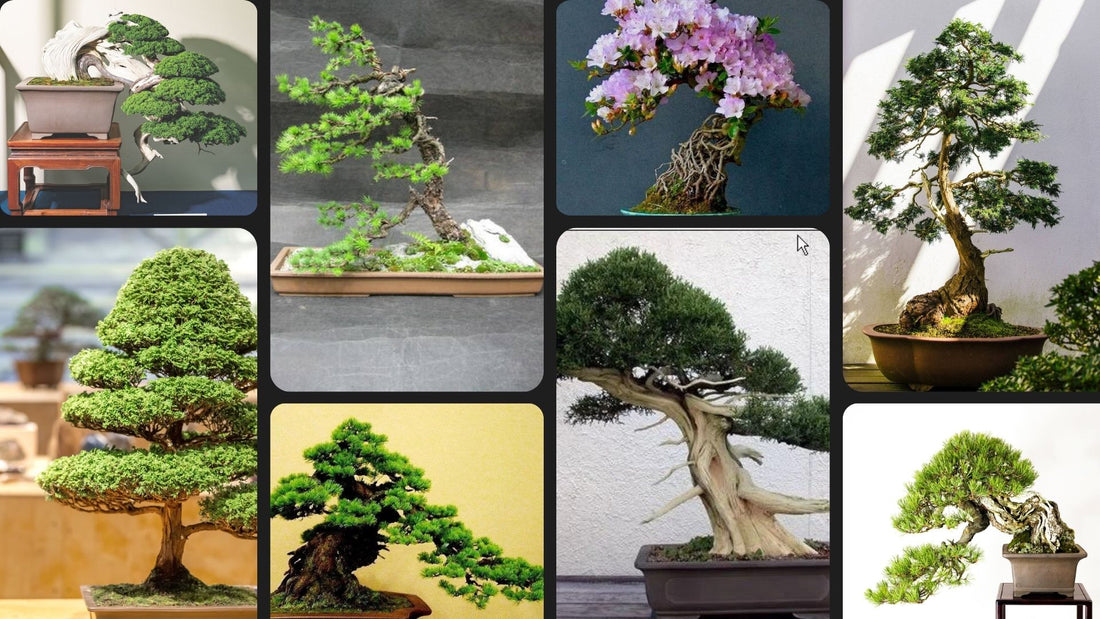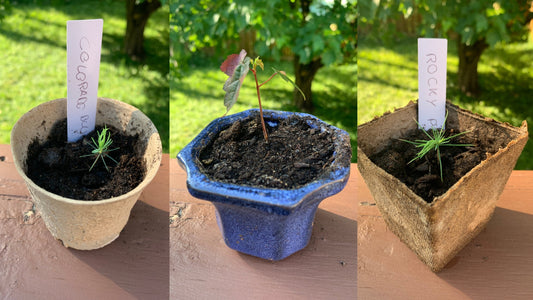1. Introduction: Discover the Art of Bonsai Shapes
The art of bonsai, a thousand-year-old tradition from Japan, is much more than a simple horticultural practice. It is a true symbiosis between nature and culture, where the miniature tree becomes a reflection of natural beauty, shaped by man with patience and devotion. Bonsai, often considered a living art form, embodies balance, harmony and serenity, values deeply rooted in Japanese culture.
As you delve into the world of bonsai, you will discover an infinite variety of shapes and styles, each with its own meaning and history. Whether you are a beginner or an experienced enthusiast, understanding these different shapes is essential to mastering the art of bonsai. This article will guide you through the main bonsai shapes, from the majestic upright to the spectacular cascade, including exposed root shapes that are sure to amaze you.
It is important to emphasize that creating these shapes requires time and patience. With our Bonsai Box starter kits, you will have the opportunity to grow your own bonsai from seeds, an exciting adventure that will allow you to observe, over the months and years, the transformation of your trees into true works of art. However, it is essential to understand that these shapes can only be shaped after a long period of growth: about ten months for some species and a few years for others. Patience is therefore the key to succeeding in this art.
This article will also offer you resources to further your knowledge, including online courses with Bonsai Empire , a reference for amateurs or experienced people wishing to master bonsai training techniques. For those who prefer a more hands-on approach, we will suggest finding local schools or associations that offer in-person training in your area.
Ready to discover the different forms of bonsai and start your own journey into this fascinating art? Let’s dive into the world of bonsai together and explore the styles that have captivated minds for centuries.
2. The Different Forms of Bonsai
The Erect Forms (Chokkan & Moyogi)
Upright forms are among the most iconic in the art of bonsai. The Chokkan, or formal upright, form is characterized by a straight, upright trunk, representing stability and strength. Each branch is arranged symmetrically, creating an image of perfection.

In contrast, the Moyogi, or informal straight, form retains a vertical trunk but with subtle curves, evoking natural beauty and adaptability. Both styles are ideal for beginners because of their apparent simplicity, but they require careful attention to maintain balance and visual harmony.

The Leaning Forms (Shakan & Fukinagashi)
Leaning shapes add impressive visual dynamics to a bonsai tree. The Shakan, or leaning, shape represents a tree that has withstood natural elements, such as wind or snow, and leaned while maintaining its vitality. This style is often used to symbolize resilience.

The Fukinagashi, or windswept, style goes even further, with the trunk and branches all leaning in the same direction, as if they were continually subjected to a strong breeze. These forms require advanced mastery of wiring to direct the tree's growth in the desired direction.

Cascading Forms (Kengai & Han-Kengai)
Cascade forms are among the most spectacular and dramatic in the bonsai world. The Kengai, or full cascade, style mimics a tree growing on a cliff, with the trunk and branches leaning down beyond the pot.

The Han-Kengai, or semi-cascade, is similar, but the trunk only descends halfway, before straightening slightly. These forms require not only technical skill, but also a deep understanding of how gravity and the environment influence the natural growth of trees.

Exposed Root Forms (Neagari)
The Neagari, or exposed roots, style is unique in its ability to reveal a part of the tree that is normally hidden: the roots. This style features roots that rise above the ground, creating an impression of strength and resilience. The process of achieving this style takes time and careful handling, as the roots must be gradually exposed as the tree grows. The end result is a bonsai that appears to spring from the earth with life force energy, capturing the very essence of survival and adaptation.

3. Take Time: The Art of Patience with our Bonsai Boxes
Growing a bonsai is a lesson in patience. Unlike classic houseplants, a bonsai does not reach its full splendor in a few weeks or even months. With our Bonsai Boxes, you embark on an adventure where every day counts, but the final result is revealed only after years of care and attention. The true beauty of a bonsai lies in the very process of its growth, where each stage of its development is a victory in itself.
When you plant your bonsai seeds, you begin a journey that never really ends. The first shoots will appear after a few weeks, but it is only after several months, or even years, that you can really begin to shape your tree into the forms we have explored previously. It is a process that requires patience, observation, and a deep understanding of how nature evolves.
Our Bonsai Boxes are designed to accompany you on this long but rewarding journey. They contain seeds from carefully selected species known for their ability to grow into magnificent bonsai trees. Each kit comes with detailed instructions to guide you through the process, from seed germination to the care of young plants and the first stages of training.

It is important to remember that creating classic bonsai shapes, such as the Chokkan, Moyogi, or Kengai, takes time. The trunk must develop sufficiently before it can be shaped, and the roots must be well established before any manipulation. This is why it is essential not to rush this process. Each cut, each wiring, must be carried out carefully, respecting the natural rhythm of the tree.
With the Bonsai Box, you not only acquire a kit to grow a miniature tree, but an invitation to embrace the art of patience. Bonsai is not a simple decoration, but an expression of nature that requires time to reach its full maturity. By investing this time, you discover not only the art of bonsai, but also a form of active meditation that connects you more deeply to nature and to yourself.
4. Learn the Techniques
Mastering the art of bonsai goes far beyond simply growing miniature trees. To create elegant and harmonious shapes, it is essential to understand and apply various cultivation and training techniques. Whether you are a novice or an experienced enthusiast, learning these techniques is a crucial step in transforming your bonsai into a true work of art.
Basic Training Techniques
Training a bonsai tree begins with basic techniques such as pinching, pruning, and wiring. Pinching involves removing new growth to encourage branching and maintain the desired shape of the tree. Pruning, on the other hand, controls the growth of the branches and trunk, ensuring that the tree maintains harmonious proportions. Wiring is an essential technique for shaping the trunk and branches, using wire to position them in the desired direction.
These techniques require precision and a thorough understanding of the tree's needs. Improper cutting or tying too tightly can damage the tree or even compromise its health. This is why it is recommended to train with experts before embarking on these practices.
Learn with Bonsai Empire
For those looking to further their knowledge, Bonsai Empire offers comprehensive online courses suitable for all levels. Their courses cover a wide range of techniques, from the basics of bonsai to advanced training methods. The courses are accompanied by explanatory videos, detailed guides, and practical exercises that will allow you to develop your skills at your own pace, in the comfort of your home. By enrolling in these courses, you will benefit from the expertise of master bonsaiists and valuable advice on how to succeed in this demanding art.

Local Trainings
If you prefer a more hands-on, interactive approach, joining a local school or association can be a great option. These institutions often offer in-person workshops and classes, where you can learn directly from professionals and network with other enthusiasts. Look for bonsai clubs in your area, as they often host events, demonstrations, and training sessions for all levels.
Whether you choose online training with Bonsai Empire or local training, the important thing is to practice regularly and not be afraid to experiment. Bonsai is a living art that evolves over time, and each step of the process is an opportunity to learn and perfect your skills.
5. Call for Interaction
Bonsai art is as much a community as it is an individual practice. As amateurs or experts, we all have a story to tell, techniques to share, and advice to give. Whether you are just starting your bonsai journey or have already sculpted magnificent trees, your experience can inspire and help other enthusiasts. That is why we invite you to share your adventures, successes, and even challenges with our community.
Share your Achievements
Have you recently started shaping your first bonsai tree? Or perhaps you’ve mastered a specific technique that transformed your tree? We’d love to see your creations and hear your stories. Post photos of your bonsai in training or one that has reached its peak. Share the steps you took, the tools you used, and the challenges you overcame. By sharing your accomplishments, you’re not only inspiring other bonsai enthusiasts, but you’re also helping to enrich bonsai culture. Join us on social media!
Ask your questions and exchange your advice
The path to bonsai mastery is filled with questions and discoveries. If you encounter difficulties or need advice, do not hesitate to ask your questions to the community. Other members, as well as ourselves, are here to help you find solutions and progress in your art. Additionally, if you have acquired expertise in a particular area, we encourage you to share your knowledge. Whether it is a tip for wiring, advice on the type of soil to use, or a recommendation on seasonal maintenance, your contributions are invaluable to all.
Join a Training
For those who want to further their skills, we encourage you to join a training course. As mentioned earlier, Bonsai Empire offers online courses for all levels, where you can learn directly from bonsai masters. If you prefer a more hands-on, hands-on approach, look for local schools or associations where you can attend workshops and in-person classes. By joining a training course, you will have the opportunity to interact with experts, practice under their supervision, and be part of a community that shares your passion.
Together, we can grow this shared passion for the art of bonsai. Whether you are a curious beginner or a seasoned practitioner, your participation enriches our community. So, engage with us, share your experiences, ask your questions, and most importantly, continue to cultivate your love for bonsai. We look forward to hearing your stories and accompanying you on this fascinating journey.




